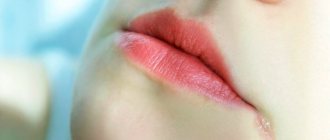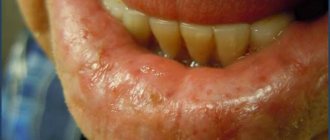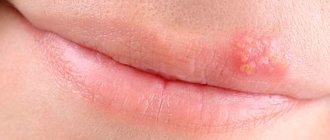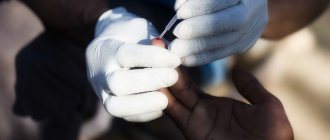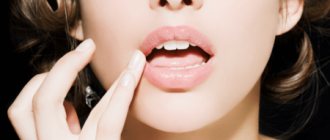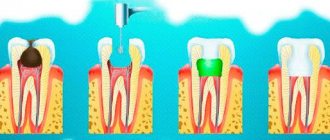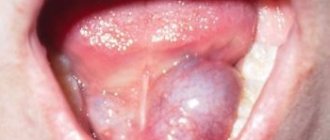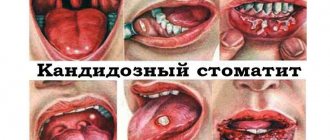A chronic inflammatory process, which is characterized by damage to the red border of the lips, is called exfoliative cheilitis. This medical term was proposed by scientists from Germany (Kemmel and Mikulic).
The peculiarity is that the pathological process is localized only in the area of the border of the skin-muscular folds that close the mouth. It does not spread to the oral mucosa and skin around the lips.
The disease is diagnosed in the female half of the population; between the ages of 16 and 20 years, the incidence rate is highest.
Causes of the disease
The etiology of exfoliative cheilitis is poorly understood, but many scientists believe that a deficiency of vitamin B2 in the body and disturbances in the central nervous system are the causes of the pathology. Doctors identify external and internal factors against which the disease manifests itself:
- stressful situations leading to exhaustion,
- neurosis in the form of anxiety-depressive syndrome,
- heredity, the disease is diagnosed in close relatives,
- various phobias,
- prolonged depression,
- a sharp decrease in the body's immune defense,
- increasing the permeability of blood vessels located in the lip area,
- thyrotoxicosis, accompanied by an increase in thyroid hormones,
- constant allergic reactions,
- nicotine abuse,
- detachment from the surrounding reality and complete indifference to what is happening, apathy,
- low quality lipstick and other cosmetics applied to the lip area,
- biting or licking the folds of skin and muscles covering the mouth in cold weather.
In recent years, many young people have been turning to doctors for emotional disorders, and the problem of exfoliative cheilitis is becoming increasingly widespread.
Features of the disease
Exfoliative cheilitis belongs to the group of chronic diseases. The pathological process appears only on the red border of the lips.
Foci of inflammation do not spread to the mucous membrane of the oral cavity. The disease develops as a result of tissue malnutrition, which occurs against the background of stress and nervous strain. The latter circumstance explains why exfoliative cheilitis more often affects women.
Pathology is more often detected in people aged 20-40 years.
Symptoms
The disease can occur in 2 forms, differing in clinical picture:
- Dry.
This type of cheilitis is diagnosed mainly in women aged 20-26 years. Main symptoms:
- Multiple transparent scales form on the lips, tightly connected to the underlying tissue in the center. They have a mica-like appearance, and when they are removed, a hyperemic area is exposed, which after a week is covered with new formations,
- there is a feeling of burning, tightness, the presence of a foreign body, which becomes the reason for the habit of biting the lips, while tearing off the crusts from them,
- dryness causes peeling of the affected area and provokes a person to lick it,
- the elasticity of the border is lost, as a result of which the risk of cracks and tissue rupture in the pathological area increases,
- gradually the scales transform into crusts that have a gray or gray-brown tint.
The dry type of cheilitis is not prone to remission and spontaneous recovery. In some cases it transforms into an exudative form.
- Exudative.
The clinical picture is characterized by the following manifestations:
- swelling of the lips, accompanied by a burning sensation,
- palpation of the affected area causes pain, which indicates the development of an inflammatory process,
- a significant number of scales in the Klein zone acquire after some time the appearance of gray-yellow crusts covering the area between the corners of the mouth with a continuous layer,
- due to the increase in size and drooping of these formations, discomfort occurs when closing the lips, which forces a person to leave his mouth half open,
- as in the previous case, removing scales or crusts from the lips,
- severe redness in the area where the border meets the oral mucosa,
- pain and discomfort while eating food, which leads to loss of appetite and conversation.
The therapeutic process contributes to the transformation of the exudative form of pathology into a dry one.
The vivid symptoms of cheilitis will easily allow a person to independently determine the presence of pathology, but only a medical specialist can accurately determine its form.
Cheilitis
Definition
Cheilitis is an inflammation of the red border, mucous membrane and skin of the lips.
Etiology and pathogenesis
The causes of cheilitis are streptococcus, staphylococcus, yeast fungus, prolonged sun exposure, denture materials, lipstick, etc.
The mechanism of development of cheilitis is associated with a deficiency of vitamin B in the patient’s body, and increased sensitivity to certain medications.
Predisposing factors for cheilitis are diseases of the endocrine organs and poor oral care. In the epithelium of the red border of the lips, parakeratosis (disruption of the process of keratinization of cells), acanthosis (thickening of the epidermis and epithelium of the mucous membranes) and large light cells are detected. A distinction is made between cheilitis itself and symptomatic cheilitis.
Cheilitis itself includes exfoliative, glandular, allergic contact, meteorological, actinic and abrasive precancrosis Manganotti cheilitis.
Symptomatic cheilitis is divided into atopic cheilitis and granulomatous cheilitis Mishcher.
The causes and mechanism of development of granulomatous Miescher cheilitis have not been fully elucidated. The pathohistological process is characterized by the formation of small delimited granulomas in the thickness of the skin of the lips. The course of Miescher granulomatous cheilitis is chronic and relapsing. After several relapses, the lip increases in size and acquires a doughy consistency.
Clinical picture
The exfoliative form of cheilitis is a chronic psychosomatic disease in which only the red border of the lips is affected. A characteristic feature of exfoliative cheilitis is the spread of the process along the entire border of the lips from one corner to the other corner of the mouth, excluding the stripes bordering the skin. The exfoliative form of cheilitis is divided into exudative and dry. They have similarities, but with the exudative form the changes are more pronounced. In the dry form, gray or brownish-gray scales resembling mica form at the site of the lesion. The exudative form of cheilitis may be preceded by a dry form. With the exudative form of cheilitis, massive yellow or brownish-yellow crusts are formed, which, when removed, reveal a smooth bright red surface without erosion. Then, a whitish inflammatory fluid appears on the red border of the lips and its inner zone (Klein’s zone), shrinking into crusts. The feeling of burning and tightening of the lips bothers me. Due to lip sticking, patients try to keep their mouth half open. The course of the disease is long.
The glandular form of cheilitis is characterized by the location of small salivary glands and their ducts in the outer and inner zones of the red border of the lips, their hyperplasia and hyperfunction. It can occur both primary and secondary, at the age of 30-40 years. During the study, a significant increase in the salivary glands and their excretory ducts, inflammatory infiltration of tissues is observed. When examined in the area of the red border of the lips, dilated mouths of the salivary glands are visible in the form of red dots, from which droplets of saliva are released in the form of dew. When the patient’s lower lip is pulled back, after 20-30 seconds, droplets of saliva appear on the mucous membrane of the lip, released from the dilated mouths of the small salivary glands, which does not happen with other cheilitis.
Allergic contact cheilitis occurs as allergic contact dermatitis. It develops as a result of increased sensitivity of lip tissue to various chemicals (for example, lipstick). It manifests itself as erythema of varying intensity, rarely - papulovesicular elements, peeling of the red border of the lips. Patients feel a burning sensation on their lips.
Meteorological cheilitis occurs as a result of exposure to various meteorological factors (low humidity, radiation, wind, cold, dust, etc.). Most often, men who work outdoors get sick; the process is localized on the lower lip. In this case, widespread uneven hyperplasia of the epithelium of the red border of the lips is noted, in places with slight keratinization. The red border of the lower lip is unevenly hyperemic and infiltrated, and in some places tightly packed scales are formed. The course is long-term, chronic, independent of the time of year. There is no sensitivity to sunlight. With meteorological cheilitis, there is no sharp border of the red spot and keratinization at the periphery of the lesions, which has the appearance of a palisade.
Actinic cheilitis develops as a result of sensitivity of the red border of the lips to sunlight and can be combined with solar eczema of the face. The process occurs and intensifies in the spring and summer. In winter, the rashes disappear without a trace. There are two forms of actinic cheilitis - dry and exudative. In the dry form, the lower lip becomes bright red, covered with small scales, and sometimes verrucous (warty) formations appear. In the exudative form, the lower lip is reddened, swollen, small, quickly opening blisters with oozing, crusts and bleeding painful cracks appear. There is burning and itching in the lip.
Abrasive precancrous cheilitis Manganotti is an obligate precancer localized on the lower lip. Older people usually get sick. Meteorological conditions, trauma, and poor circulation in the lower lip contribute to the disease. They find limited proliferation of the epithelium with symptoms of atypia, especially in epithelial outgrowths. In the center of the growth focus there is an epithelial defect filled with a thick infiltrate. On the red border of the lower lip, one or two superficial erosions (defect of the mucous membrane) appear red in color with a smooth surface, sometimes crusts form. The course of the disease is long, erosions can heal, but then reappear in the same or another place.
Atonic cheilitis is one of the symptoms of atonic dermatitis. In this case, the red border and the skin of the lips are affected, and the process is most pronounced in the corners of the mouth. The part of the red border that passes into the oral mucosa is not affected. Lip damage begins with itching, red spots and slight swelling. The process never extends to the oral mucosa. The red border infiltrates, peels off, its surface takes on the appearance of a harmonic due to radial grooves:
In the summer, the rashes disappear and only the skin in the area of the corners of the mouth remains infiltrated, which contributes to the appearance of cracks.
Granulomatous cheilitis Miescher is characterized by macrocheilia, persistent thickening of the lips (usually the lower) of an inflammatory nature.
Diagnostics and differential diagnostics
The diagnosis of exfoliative cheilitis is based on a specific localization of the process, a typical clinical picture, and the absence of primary morphological elements. It is differentiated from atopic cheilitis, contact and actinic cheilitis, lesions of the lips in pemphigus, systemic lupus erythematosus.
The diagnosis of allergic contact cheilitis is made on the basis of survey data (contact with a chemical substance) and the clinical picture. A skin test with a chemical substance can confirm the diagnosis.
The diagnosis of meteorological cheilitis is made based on survey data, tissue examination and clinical course. Differential diagnosis is made with systemic lupus erythematosus, in which synthetic antimalarial drugs have a positive effect.
The diagnosis of actinic cheilitis is made based on the connection of the disease with radiation in the spring-summer period and the localization of the process on the lower lip. Differential diagnosis is made with squamous lung cancer.
The diagnosis of Manganotti's abrasive precancrotic cheilitis is made based on survey data and the clinical picture. Differential diagnosis is carried out with pemphigus, herpetic erosion, erosive-ulcerative form of lichen planus, systemic lupus erythematosus, erosive leukoplakia, etc.
Differential diagnosis of atopic cheilitis must be carried out with exfoliative, actinic and allergic contact cheilitis, as well as lupus erythematosus of the lips. Lupus erythematosus of the lips is characterized by hyperkeratosis (increased keratinization) and a snow-white glow of scales in the rays of a Wood's lamp, cicatricial atrophy and lack of itching. Atopic cheilitis is differentiated from symmetrical streptococcal and candidal infections, in which the process is localized only in the corners of the mouth.
The diagnosis of Miescher granulomatous cheilitis is made based on a clear clinical picture.
Treatment
When treating the exudative form, sedatives, antidepressants, and acupuncture according to the second option are prescribed, which gives an inhibitory effect.
Treatment of the glandular form is surgical: removal or electrocoagulation of each salivary gland. Secondary glandular cheilitis disappears after the underlying disease is cured.
Treatment of allergic contact cheilitis consists of eliminating the allergen, using prednisolone ointment and emollient creams topically.
Treatment of meteorological cheilitis should be aimed at eliminating adverse external influences. Vitamins B2, B6, B12 are prescribed, along with local photoprotective creams and prednisolone ointment.
Treatment of Manganotti's abrasive precancrosis cheilitis includes sanitation of the oral cavity, oral administration of vitamins A and B, methyluracil and theonicol; external corticosteroid and methyluracil ointments. If there is no effect of treatment within 2 months, they resort to surgical excision of the affected lesions.
Treatment of atopic cheilitis is aimed at the underlying disease. Corticosteroid ointments, pastes are used locally, and in persistent cases, Bucca rays (long-wave x-rays) are used.
Treatment of Miescher granulomatous cheilitis is aimed at eliminating symptoms, sometimes resorting to surgical excision of the affected part of the lip.
Prevention
Prevention consists of timely treatment of cheilitis, which prevents the occurrence of lip cracks, erosions, precancerous diseases and cancer developing from the epithelium of the red border of the lip. Prevention of allergic contact cheilitis consists of preventing re-sensitization.
Prevention of meteorological cheilitis consists of protecting the lips from damaging external influences.
Prevention of abrasive precancrosis Manganotti cheilitis involves sanitation of the oral cavity, timely dental prosthetics, and the exclusion of mechanical and chemical irritations of the lower lip.
Prevention of Miescher granulomatous cheilitis has not been developed.
Diagnosis of the disease
If the symptoms described above occur, you must contact your dentist, who will carry out the following diagnostic measures:
- interviewing the patient about the nature of the symptoms, the presence of bad habits and chronic diseases of the thyroid gland or psycho-emotional disorders,
- examination of the affected area to determine the form of the disease,
- palpation of regional lymph nodes will be negative,
- the study consists of removing a small sample of tissue and examining it under a microscope to identify the nature of the pathological process. The study reveals acanthosis (induration), parakeratosis and hyperkeratosis (keratinization of the epithelium and its subsequent proliferation),
- to clarify the cause of the pathology or the presence of a history of nervous disorders and thyrotoxicosis, the patient is referred for consultation to an endocrinologist, neurologist or psychiatrist,
- Ultrasound of the thyroid gland,
- blood test for hormone levels.
Differential diagnosis is carried out to clarify the form of pathology:
- during meteorological cheilitis, the pathological process is observed on the entire surface of the red border, and inflammatory changes are more pronounced,
- The atopic form is characterized by the spread of the pathological process to the outer cover of the lips in the area of the corners of the mouth. Lichenification is noted and patients complain of itching,
- in the case of contact allergic cheilitis, there is severe redness of the affected area due to dilation of the capillaries, itching and rashes that stop after stopping contact with the allergen,
- The eczematous form of the pathology is characterized by the presence of blisters and erosion. The affected area extends to the face area. Frequent changes in phases of exacerbation and remission are observed,
- with actinic cheilitis, the influence of insolation on the course of the disease is observed. The main symptom is the presence of spherical bubbles (vesicles), in place of which erosion forms,
- lupus erythematosus, which occurs in the erosive-ulcerative form, is characterized by such pathological signs as erosion and ulcers, erytherma, cicatricial atrophy, as well as a bluish glow of the scales, which appears when illuminated with a Wood’s lamp.
Exfoliative cheilitis: signs, symptoms
How to distinguish exfoliative cheilitis from other diseases?
- It is localized only on the lips and is chronic.
- The skin and mucous membranes are not affected by this diagnosis
- Women between 20 and 40 years of age are most often susceptible to this disease.
Cheilitis is localized on the lips and does not affect the skin around them.
The main signs of cheilitis are:
- grayish-yellowish dead skin flakes on almost the entire red surface of the lips
- swelling of lips
- roughness
- a slight burning and itching sensation
- discoloration - lips become bright red
When the scales fall off, the place where they were recently located begins to irritate and bleed.
The main sign of cheilitis is the appearance of grayish-yellow scales on the lips
IMPORTANT: Often microbes get into open wounds of cheilitis, an inflammatory process begins, as a result of which pus can be released from the wounds and the disease is complicated by a bacterial infection.
Treatment methods for dry form
Therapy begins by prescribing the following drugs to the patient:
- tranquilizers and sedatives to suppress depressive states, which must be taken for 1 month. (Coaxil, Phenazepam, Trioxazine, Melipramine, Relanium, etc.). Their action is aimed at eliminating psycho-emotional disorders, which are the main cause of the disease,
- To increase immunity and restore normal levels of vitamin B2 in the body, you need to take multivitamin complexes.
Local treatment includes the following procedures:
- carrying out sanitation of the oral cavity,
- the use of keratoplasty in the form of applications to the affected area (Aekol, vitamin A oil solution, Keratolin, sea buckthorn oil). The procedure is carried out 3 times. per day, its duration is 20 minutes,
- maintaining careful oral hygiene is necessary to avoid infection of the area of inflammation,
- When going outside, lips should be covered with a thin layer of hygienic lipstick, indifference cream,
- in most cases, a daily blockade is carried out, for which 2% Novocain and aloe extract are used.
Psychotherapy may also be required:
- auto training,
- hypnosis,
- relaxation,
- electrosleep.
Therapy for the dry form is long-term, but if the patient follows all the recommendations of the attending physician, there is the possibility of a complete cure.
Treatment of exfoliative cheilitis
The treatment of the disease is approached based on the causes of its occurrence and symptoms. An individual approach, complexity, consistency and systematicity are important.
The exudative form of the disease is often confused with:
- actinic cheilitis (exudative course);
- true pemphigus;
- lichen planus and lupus.
The dry type is often confused with such varieties of cheilitis as meteorological, allergic and atopic. Differential diagnosis is necessary for adequate treatment of the disease.
First, you need to force yourself to give up smoking, licking and biting lips, biting scales, and holding a pencil in your mouth. Your doctor may recommend taking a course of psychotherapy. Before starting drug treatment, you must consult an endocrinologist and allergist.
Treatment of dry form
Therapy includes a list of activities:
- Professional oral hygiene, dental treatment if necessary.
- Applications using keratoplasty (retinol, tocopherol for 15-20 minutes per day) to accelerate the restoration of the epithelium.
- Ointments and creams (hydrocortisone) - to protect the red edge of the lips from sun rays.
General treatment consists of the use of antipsychotics (Melleril, Thioridazine, Sonapax), antidepressants (Melipramine, Amitriptyline), tranquilizers (Sibazon; Relanium; Seduxen), as well as multivitamins with minerals.
Treatment of exudative form
Treatment is the same as for the dry form. Additionally, physiotherapy is prescribed - helium-neon laser, UV irradiation, ozone therapy. Sometimes Bucca rays are used.
In addition to sedatives, tranquilizers and multivitamins, antihistamines (Hifenadine, Cetirizine, Clemastine, Chloropyramine) are prescribed. They help reduce sensitization, prevent the development and alleviate allergic reactions.
Indicators of the effectiveness of therapy are:
- disappearance of pain;
- absence of scales and crusts;
- stable remission.
Treatment with folk remedies
Aloe vera is a wonderful antiseptic and also perfectly nourishes the affected surface of the lips. The leaves of the plant are crushed to a paste and applied to the damaged areas for 10-15 minutes. Repeat the procedure 3-5 times during the day.
A decoction of sage leaves heals the surface of the lips well. 3 tablespoons of dry raw materials are poured into 500 ml of boiling water, boiled for 15 minutes in a water bath. The cooled infusion is used as a lotion, applied to damaged skin. Leave for half an hour 3-4 times a day.
Pour 3-4 tablespoons of oak bark into 200 ml of cold water. Bring to a boil in a water bath and leave for 15 minutes. Moisten a lint-free napkin in a decoction cooled to room temperature, apply to the surface of the lips for 15-20 minutes, up to 7 times during the day.
The treatment of exfoliative cheilitis must be approached comprehensively. Since this disease has many causes (psycho-emotional, hormonal, immune), it is necessary to undergo consultation with doctors such as a neuropsychiatrist, an immunologist, an endocrinologist. It is important to constantly moisturize the surface of your lips with oil solutions or balms.
Exudative form of cheilitis and its treatment
Local therapy includes the following procedures:
- professional cleaning and sanitation of the oral cavity, and at home, mandatory hygiene procedures in this area,
- use of keratoplasty for applications and Solcoseryl 3-4 r. per day for 20 minutes,
- applying corticosteroid ointments to the affected area, which contain prednisolone and hydrocortisone. The time and number of manipulations coincides with the previous procedure,
- solutions of Trimecaine or Lidocaine are used to carry out blockades. They are performed alternately on different lips (the first day – lower, the second day – upper),
- impact on the area affected by Bukki's border rays. The crusts are first removed using 2% boric acid. The therapeutic course lasts about 6 months, sessions are held 2 times. in Week.
For the effectiveness of treatment, the following drugs are additionally prescribed:
- sedatives or tranquilizers. The dosage is selected individually for each patient,
- multivitamin complexes,
- Pyrogenal – increases the body’s reactivity. Its reception is carried out according to the scheme. For the first 2 days, the dose is 50 MTD, then it increases to 150 MTD and is gradually increased to 1000-1500 MTD. The course lasts from 7 to 10 days,
- adrenergic blockers (Anaprilin),
- histaglobulin or gamma globulin – 2 rubles. per week 2 ml.
Treatment courses of psychotherapy, ultraphonophoresis and acupuncture are also used.
When diagnosing this form of the disease, it is necessary to undergo at least 3 therapeutic courses, with a break between them of 7-8 months.
General recommendations
In order for the treatment to bring positive results, the patient must adhere to all the recommendations of the attending physician:
- girls are advised to stop using various decorative cosmetics,
- follow a diet that involves eliminating from the diet foods that irritate the surface of the lips (fried, spicy, sour and fatty foods),
- strengthen the immune system through the use of vitamin complexes,
- undergo a course of psychotherapy to eliminate various psycho-emotional disorders,
- attend procedures,
- in the presence of thyrotoxicosis, follow the recommendations of the endocrinologist.
Compliance with these rules will guarantee the effectiveness of the therapeutic course and help avoid relapses.
Do you feel nervous before visiting the dentist?YesNo
Prevention of cheilitis
Due to the pathogenesis of the disease not being fully studied, doctors recommend adhering to the basic rules of prevention:
- carry out hygienic procedures to clean the oral cavity in a timely and thorough manner,
- do not abuse alcohol and stop smoking,
- mandatory intake of vitamin complexes in the autumn-winter period,
- enriching the diet with vegetables and fruits,
- use high-quality decorative cosmetics,
- protect your lips in frosty weather with hygienic lipstick,
- If you have a history of thyroid pathologies, undergo timely treatment.
Maintaining a healthy lip surface is the key to an aesthetically pleasing appearance. To preserve it, it is recommended to adhere to the rules of prevention.
It is easy to recognize the problem, but its treatment may take time, so consult a doctor if you experience bad sensations in the area of the skin-muscle folds that close the mouth.
